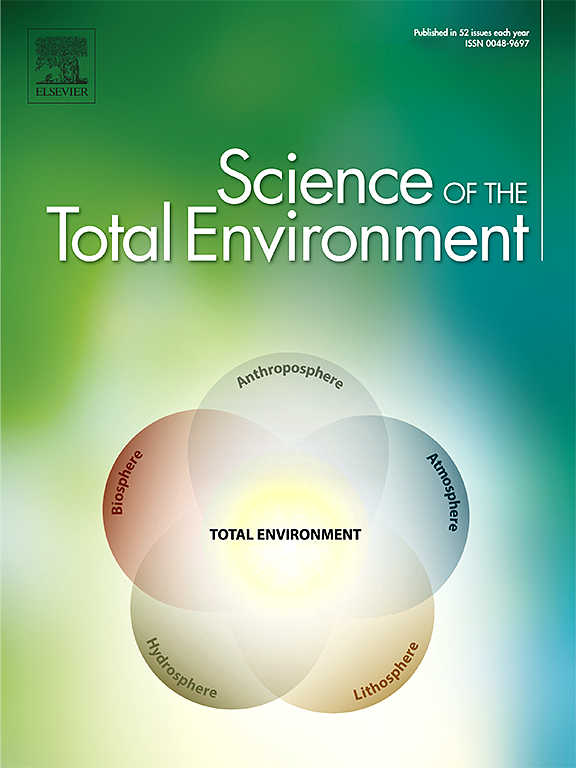利用生物碳基纳米材料作为过硫酸盐活化催化剂,高效同时降解土壤中多种磺胺类抗生素。
IF 8.2
1区 环境科学与生态学
Q1 ENVIRONMENTAL SCIENCES
引用次数: 0
摘要
目前迫切需要开发有效和可持续的方法来减少磺胺(SA)对土壤的污染。本文提出了一种零价金属-生物炭基复合材料的非均相体系,并对过硫酸盐(PS)的活化进行了测试。该系统采用零价铁(Fe0)作为电子供体,催化PS中OO键的断裂,从而产生降解SAs的活性氧(ROS)。值得注意的是,单质硫(S)的加入显著减轻了Fe0的钝化,从而增强了系统的降解能力。该体系在3 h内分解土壤悬悬液中浓度为10 mg/kg的84- 97%的SAs。在几种SAs共存的情况下,该体系对磺胺恶唑的降解速度最快,降解时间为0.0305 min-1,在3 h内接近完全去除。该体系对土壤中有机物的影响具有抗性。该系统可以在2小时内将实际污染土壤中的磺胺嘧啶浓度降低73%。当PS浓度从20 mM降低到2.5 mM时,该系统仍然有效,从而降低了运行成本。T.E.S.T软件评价表明,降解产物的生物蓄积毒性和发育毒性显著降低,表明该体系是环境友好型的。该技术具有催化体系效率高、制造工艺简单经济、抗土壤干扰、环境友好等优点,有望缓解硫酸盐对环境的污染问题。本文章由计算机程序翻译,如有差异,请以英文原文为准。

Efficient simultaneous degradation of multiple sulfonamide antibiotics in soil using biocarbon-based nanomaterials as catalysts for persulfate activation
There is an urgent need to develop effective and sustainable methods to decrease sulfonamide (SA) contamination of soil. Herein, a non-homogeneous system of zero-valent metal-biochar-based composites was proposed and tested for persulfate (PS) activation. This system employed zero-valent iron (Fe0) as an electron donor to catalyze the cleavage of the O![]() O bond in PS, thereby generating reactive oxygen species (ROS) that degrade SAs. Notably, the incorporation of elemental sulfur (S) significantly mitigated the passivation of Fe0, leading to an enhanced degradation capability of the system. The system decomposes 84–97 % of SAs at their concentration in soil suspension 10 mg/kg in 3 h. Among the coexistence of several SAs, the system showed the fastest degradation rate of sulfisoxazole with a kobs of 0.0305 min−1, nearing complete removal within 3 h. The system is resistant to the impact of organic matter in soil. It allows to decrease concentration of sulfadiazine in actual contaminated soil on 73 % in 2 h. The system remains effective with decreasing concentrations of PS from 20 mM to 2.5 mM, which lowered the operating cost. T.E.S.T software evaluation showed a significant reduction in the bioaccumulation toxicity and developmental toxicity of the degradation products, suggesting that the system is environmentally friendly. The high efficiency of the catalytic system, the simplicity and economy of the manufacturing process, the resistance to interference in real soil, and the environmental friendliness make this technology promising for mitigating the problem of the environment contamination by SAs.
O bond in PS, thereby generating reactive oxygen species (ROS) that degrade SAs. Notably, the incorporation of elemental sulfur (S) significantly mitigated the passivation of Fe0, leading to an enhanced degradation capability of the system. The system decomposes 84–97 % of SAs at their concentration in soil suspension 10 mg/kg in 3 h. Among the coexistence of several SAs, the system showed the fastest degradation rate of sulfisoxazole with a kobs of 0.0305 min−1, nearing complete removal within 3 h. The system is resistant to the impact of organic matter in soil. It allows to decrease concentration of sulfadiazine in actual contaminated soil on 73 % in 2 h. The system remains effective with decreasing concentrations of PS from 20 mM to 2.5 mM, which lowered the operating cost. T.E.S.T software evaluation showed a significant reduction in the bioaccumulation toxicity and developmental toxicity of the degradation products, suggesting that the system is environmentally friendly. The high efficiency of the catalytic system, the simplicity and economy of the manufacturing process, the resistance to interference in real soil, and the environmental friendliness make this technology promising for mitigating the problem of the environment contamination by SAs.
求助全文
通过发布文献求助,成功后即可免费获取论文全文。
去求助
来源期刊

Science of the Total Environment
环境科学-环境科学
CiteScore
17.60
自引率
10.20%
发文量
8726
审稿时长
2.4 months
期刊介绍:
The Science of the Total Environment is an international journal dedicated to scientific research on the environment and its interaction with humanity. It covers a wide range of disciplines and seeks to publish innovative, hypothesis-driven, and impactful research that explores the entire environment, including the atmosphere, lithosphere, hydrosphere, biosphere, and anthroposphere.
The journal's updated Aims & Scope emphasizes the importance of interdisciplinary environmental research with broad impact. Priority is given to studies that advance fundamental understanding and explore the interconnectedness of multiple environmental spheres. Field studies are preferred, while laboratory experiments must demonstrate significant methodological advancements or mechanistic insights with direct relevance to the environment.
 求助内容:
求助内容: 应助结果提醒方式:
应助结果提醒方式:


